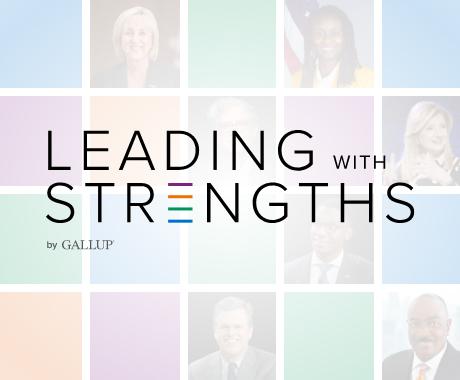Story Highlights
- Setting career goals with your strengths in mind allows you to cater to your natural abilities
- Using strengths to set goals can make them more meaningful
- Combine wellbeing, engagement and strengths to successfully achieve goals
It's that time of year again -- the time to set new goals or discover new ways to achieve old ones.
And the best way to do that? Start with strengths.
Even the most engaged and thriving employees benefit significantly when they use their strengths at work. That's why setting goals with strengths in mind is a vital part of actually achieving those goals.
In fact, recent studies from Gallup have shown that operating within a culture that places a strong emphasis on strengths can significantly improve key performance indicators like turnover, productivity and absenteeism -- and modern performance indicators like hope, adaptability, wellbeing, resilience and stress mitigation.
Certainly, setting SMART (specific, measurable, achievable, relevant and timely) or OKR (objectives and key results) goals is a great way to create meaningful outcomes. But you can take it a step further by applying what Gallup has discovered about success in the workplace: It requires strengths.
Discover strengths-based goal setting.
Setting goals with your strengths in mind allows you to cater to your natural abilities while challenging you to use your talents in new ways.
Strengths-based goals help you steer away from only focusing on the things that you need to fix or become better at.
To get started, identify the tasks you perform with ease, excellence and enjoyment. These tasks are clues that you're using your talents. Now consider the goals you set -- are these tasks part of those goals? They should be. Using your talents as you strive for your goals creates the greatest opportunities for exponential growth and world-class performance.
The four CliftonStrengths domains -- strategic thinking, relationship building, influencing and executing -- offer a way to categorize the different themes. But more than that, they can inspire what kinds of goals you should set and help you understand how to use your strengths to achieve those goals.
For example:
If Learner or Analytical is in your top five, you could use these strategic thinking themes as motivation to stay on the leading edge of information specific to your role or industry.
If you have high Harmony or Empathy, you might consider capitalizing on your ability to detect others' emotions by creating goals that help you and your team reduce conflict.
If you lead with Communication or Significance, it might be helpful to set goals that focus on influencing others because you have a natural ability to speak concisely about topics that are important to your audiences.
And if you are strong in themes such as Focus or Achiever, consider goals that are a roadmap to your desired outcomes -- ones that highlight your desire for productivity and results.
Setting strengths-based goals helps you identify what is important to you, how you want to grow and what changes you would like to see. This is a breath of fresh air if you typically set goals to fix things about yourself that you perceive as "broken" or that aren't designed to help you grow.
Setting goals with your strengths in mind allows you to cater to your natural abilities while challenging you to use your talents in new ways.
Strengths creates a solid foundation for setting goals -- while wellbeing and engagement help you outline the types of goals you should set.
Why is it important to set goals about wellbeing?
Wellbeing is the foundation of everything that we aspire to accomplish. If we neglect the key tenets of wellbeing, our endeavors seem hard -- we feel like we are struggling or, even worse, suffering. But when we set our goals to address the five elements of wellbeing -- career, social, financial, physical and community (specifically career wellbeing) -- and work toward achieving those goals, we can make our aspirations a reality.
As you set new goals, find ways to integrate all five elements. For example, setting a goal to exercise at least three days per week will be good for your physical wellbeing, but how might that also contribute to the other elements, such as your career wellbeing?
And how might achieving some of your career goals influence things like your ability to contribute to the greater good (community wellbeing) or your relationships with your closest friends and family members (social wellbeing)?
Set your goals using the components of engagement.
Finally, if you're looking for a good place to start when deciding what types of goals to set, think about your workplace engagement. Your engagement at work will also affect your wellbeing, making "increased engagement" a prime goal.
What, to you, are the components of a healthy career? One in which you want to commit your time, talents and much of your energy? While the mark of a healthy career can differ from person to person, Gallup has discovered 12 employee needs that must be met for an engaged and productive workplace.
Understanding these elements of employee engagement can help you establish goals and habits that are aligned with the most productive and high-performing employees. Knowing what is expected of you at work is the most foundational element of employee wellbeing, yet only about 50% of employees strongly agree they know what is expected of them at work. Shore this element up with your manager before you begin your list of goals.
As you look through your list, keep all 12 engagement elements in mind.
The research tells us that the combination of focusing on strengths, wellbeing and engagement can produce exceptional outcomes. Integrating these three components into your 2024 goals will help you achieve new heights.
Learn more about strengths-based goal setting:
- Download this Strengths-Based Goal Setting template for a clear framework for setting goals.
- Check out How to Set Goals (Then Achieve Them) Using CliftonStrengths to learn how to achieve goals in a way that comes naturally to you.
- Want to discover your strengths to set better goals? Take the CliftonStrengths assessment.
Gallup®, CliftonStrengths® and each of the 34 CliftonStrengths theme names are trademarks of Gallup. Copyright © 2000 Gallup, Inc. All rights reserved.





